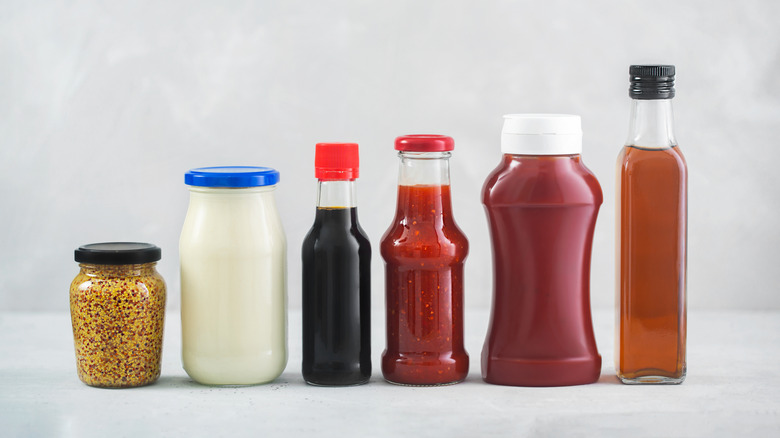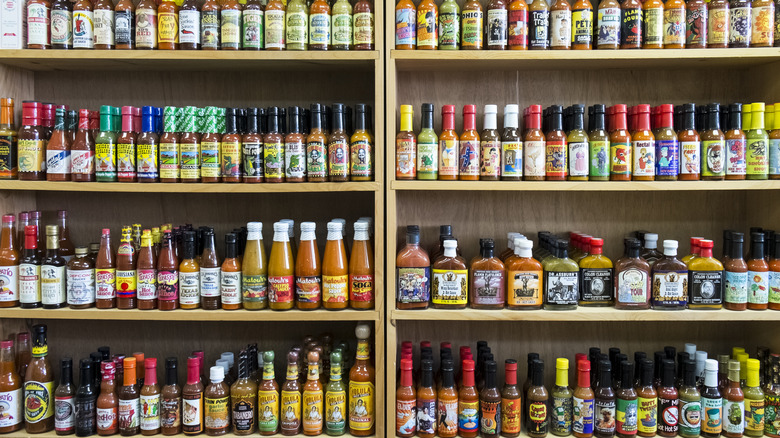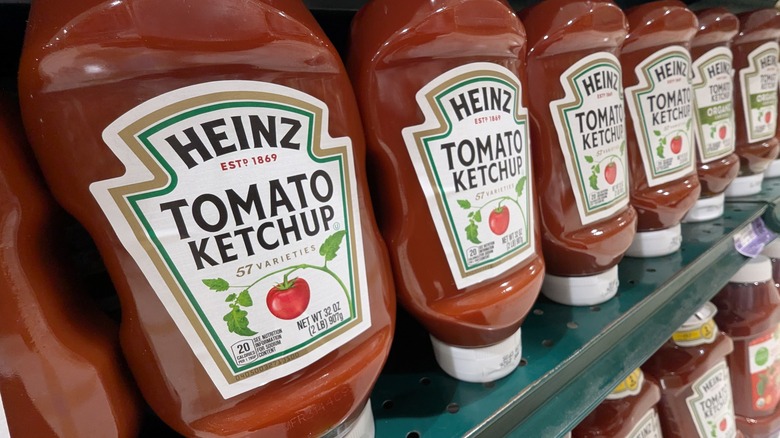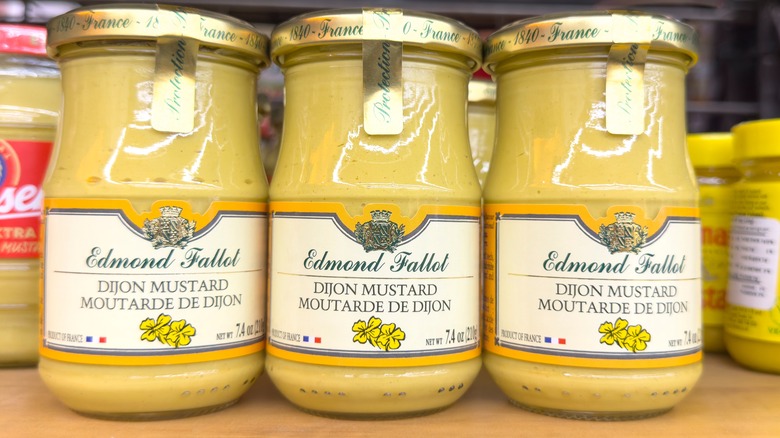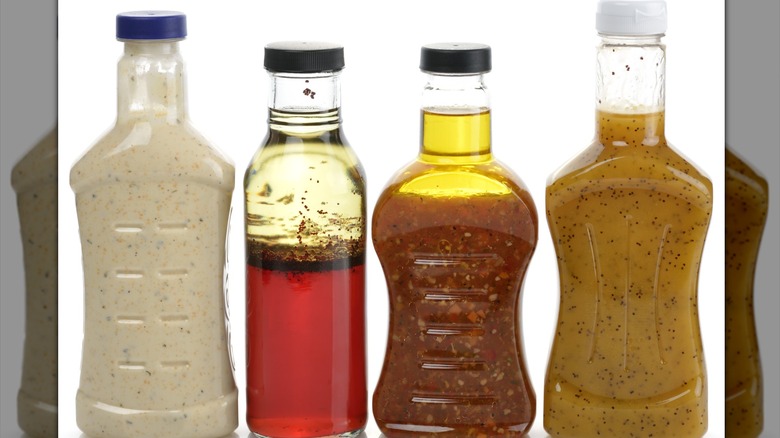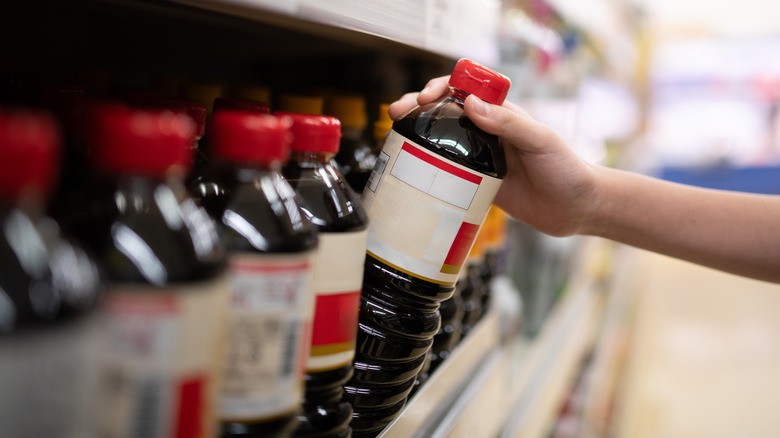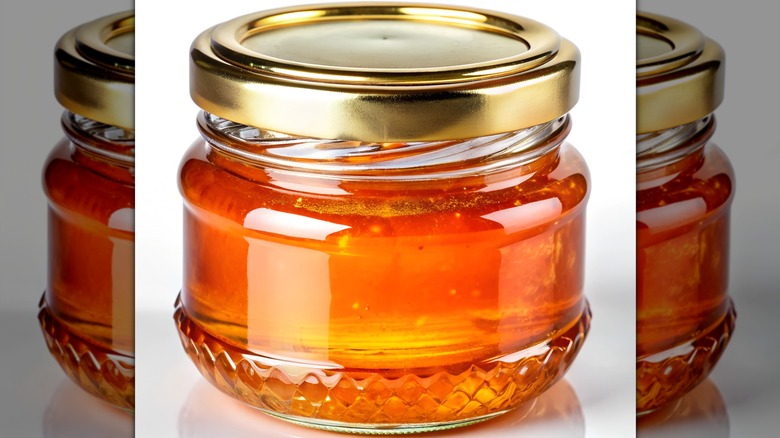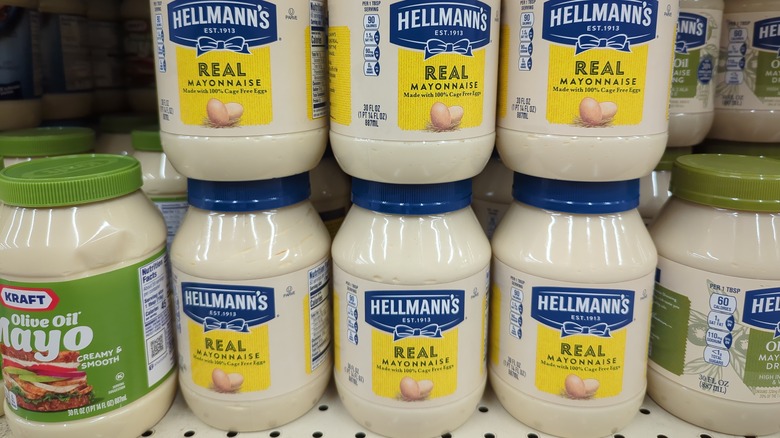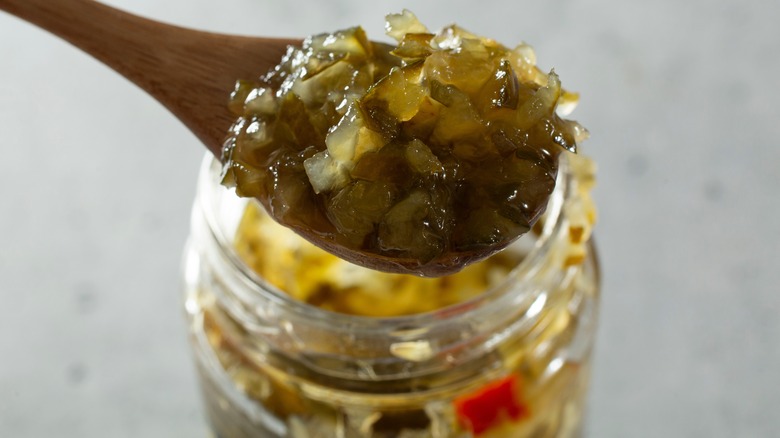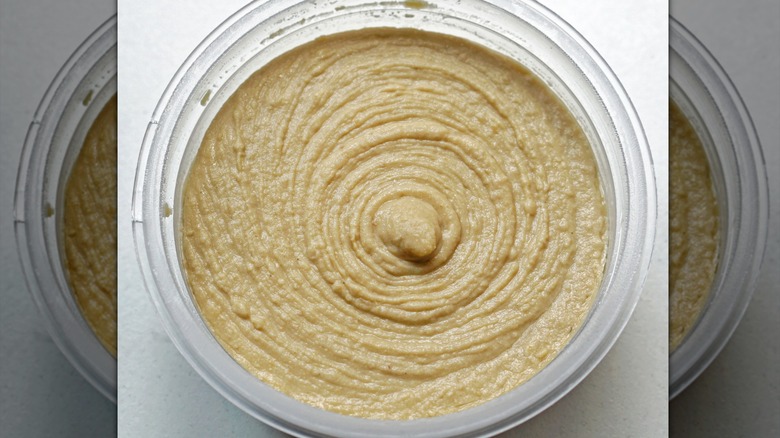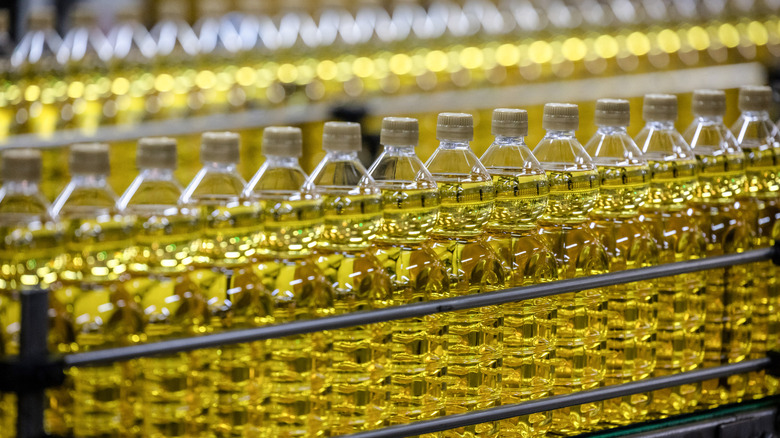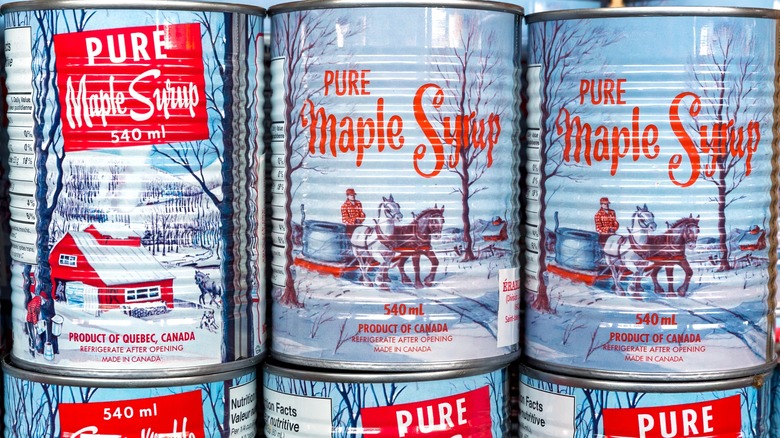11 Condiments That May Go Up In Price In 2025
We may receive a commission on purchases made from links.
When President Donald Trump unleashed his international laundry list of reciprocal tariffs on April 2, 2025 (or as Trump called it, "Liberation Day"), Americans were left wondering how this sweeping policy would affect the prices of everything from clothing to electronics to condiments. Food manufacturing companies are among the businesses that have already announced plans to raise prices in 2025. Condiments imported from other countries could go up in price to offset the costs that manufacturers incur due to the tariffs; however, the new tariffs aren't the only reason why some condiments may become pricier.
As you've probably noticed, groceries have gotten pretty expensive in the last few years. That's because of inflation. As the world coped with the fallout from the COVID-19 pandemic, supply chain disruptions drove inflation upward, and the situation has been slow to improve. For food manufacturers, the effects of climate change coupled with rising costs in energy, raw materials, and labor present additional challenges. Condiments produced in North America are not subject to tariffs, but if they contain imported ingredients or costly raw materials, their prices may increase anyway. Here are 11 condiments that are projected to get more expensive in 2025.
Hot sauce
The future of low-priced hot sauce in the U.S. doesn't look all that smokin'. In the summer of 2024, there was a sriracha shortage after a drought made Mexican chili peppers (a crucial sriracha ingredient) scarce. This came on the heels of supply chain issues during the pandemic that left the spicy condiment in short supply. Still, the hot sauce industry is expected to continue its upward trajectory of growth. Its annual global revenue increased by $50 billion between 2019 and 2023, Vox reported. Considering hot sauce's high demand and frayed supply chain, this is a crowded condiment category dependent on a shaky set of socio-political factors.
When a drought season results in a low output of chilis, big brand hot sauces and artisanal companies are left scrambling over how to keep their operations running as usual. To compensate for lowered production numbers, some companies raise prices at the consumer level. Since the hot sauce sector is so jam-packed with artisans as it is, some small-batch hot sauces could sell for upwards of $14 to $40 a bottle.
Another facet of the forecasted cost jump pertains to President Donald Trump's aggressive stance on deportation. Agricultural field workers legally authorized to work in the U.S. command a higher wage than non-legal workers — who make up a large number of the people harvesting seasonal crops. As for hot sauce's inextricable relationship with Mexican chilis, importing them (and all other produce) to the U.S. is currently tariff-free under the provisions of the United States-Mexico-Canada Agreement (USCMA), though this is something Trump has toyed with rescinding in recent months.
Ketchup
In the U.S., ketchup's legacy is long and legendary, and the thought of it getting more expensive feels downright un-American. Alas, one of the big pitfalls plaguing the ketchup industry has less to do with patriotism and more with the forces of Mother Nature. Over 90% of tomatoes grown in the U.S. come from California, where droughts over the last five years have devastated growing seasons, Climate Ai reports. Extreme heat also degrades the quality of Heinz and Roma tomatoes that give ketchup its deep red color.
Amid the 2022 drought — which was called the worst in a millennium — commercial tomato farms were being hit with heightened prices for fuel, labor, fertilizer, and groundwater reservoirs, which farmers had to tap into once their rainwater reservoirs were reduced. The California Tomato Growers Association rallied for a 5.6% increase in tomatoes' sale price and warned consumers of the possibility of a shortage. Abroad, tomato growers in Italy and China were also experiencing dismal harvest seasons due to elevated heat.
These troubling trends create a situation where ketchup companies will be forced to keep raising prices as they strategize for the future. Ketchup leader Kraft Heinz has already sought out more resilient tomato seeds and different growing regions. Ketchup may not be immune from President Donald Trump's tariffs either. Processed food giant Conagra, the brand behind Hunt's ketchup, already announced it will raise prices to counteract projected import taxes on palm oil, olive oil, cocoa, and tin mill steel used in many of its products.
Dijon mustard
European mustard truly is one of life's finer pleasures, but when the president came in like a wrecking ball on Liberation Day, Dijon lovers had reason to worry. Condiments imported from any nation other than Canada or Mexico are looking at an import tax of at least 10%. The news adds insult to injury for Dijon mustard. It's one of the oldest types of mustard, but the Dijon industry has been in a world of trouble since 2021.
It's a story that is becoming all too familiar: Climate change is creating huge problems for food manufacturers all over the world. Canada, the nation responsible for supplying 80% of the world's brown mustard seeds, has seen its harvests crippled by drought, the BBC reports. In the Burgundy region of France, where mustard crops once thrived, wet winters that gave way to a beetle infestation pushed the supply chain to its limits. As a result, Dijon became expensive and scarce in its home nation. Will Dijon's dark days be spreading to the U.S. in 2025?
Maybe. The Dijon name isn't restricted with an Appellation d'Origine Contrôlée (AOC) or Appellation d'Origine Protégée (AOP) designation the way Champagne is, so the recipe can be produced anywhere and still be considered genuine. In fact, one of the most famous of all Dijons, Grey Poupon, has been made in America for decades. Without a doubt, the biggest threat to American-made Dijon's affordability is global warming.
Salad dressing
You might see higher sticker prices in the salad dressing aisle in 2025, and the reason has a lot to do with the sticker on the back of the bottle, where the ingredients are listed. Major brands like Kraft, Ken's Steak House, and Wish Bone typically produce bottled salad dressings with long ingredient lists due to their processed nature. In light of President Donald Trump's robust tariff initiative, common salad dressing ingredients including palm oil, cheese, anchovy, and dried garlic are vulnerable to new import taxes while also facing significant supply chain obstacles perpetuated by global warming.
According to data reported by the U.S. Department of Agriculture (USDA) in 2022, the nation imported 82% of its palm oil supply from Indonesia, for an annual total value of $2.2 billion. The U.S. is also the world's leading importer of anchovy. As for cheese, many salad dressing companies rely on the American-made version of parmesan, but brands that utilize genuine parmesan are likely importing it from Italy. The easiest way for salad dressing brands to prevent tariffs on imported goods from eating into their profit margins is to increase retail prices.
Dried garlic is a common addition to bottled salad dressing, and that could prove problematic for price points in 2025. About 60% of dried garlic in the U.S. is imported from China, Global Growth Insights reports. On Liberation Day, China was Trump's main target. He set China's reciprocal tariffs at 125%, which gets added to the 20% tariff already in place for some Chinese imports — by far the highest duty of any nation.
Soy sauce
In the wake of President Donald Trump's on-again-off-again tariffs initiation, shoppers couldn't resist the urge to panic-buy items they feared would skyrocket in price once the new policy took hold. One of the items that people were stockpiling was soy sauce. Americans have a real affection for soy sauce, which has origins stretching back to ancient China and goes perfectly with sushi. Imported soy sauce from several Asian nations is widely sold in the U.S., but because it's such a marketable condiment in the states, major soy sauce producers like Japanese Kikkoman and Hong Kong-based Lee Kum Kee have domestic production facilities.
Soy sauce brands that are bottling their products in the U.S. won't be subject to tariffs on the condiments themselves; however, any imported items used in commercial soy sauce production (like machine parts made from industrial-grade steel), will be. Relying on tariffed goods means the bottles become more expensive to make. This increase could be passed down to soy sauce consumers in 2025 — in fact, it has happened before.
Shoppers got a taste of soy sauce price hikes in a few years ago. In October 2021, international soy sauce supplier Foshan Haitian Flavoring and Food Co. announced a 7% price increase in response to global inflation. Kikkoman raised its prices by 10% in November 2021, citing a cost increase in raw materials and logistic fees. It was the first time the popular soy sauce brand had increased its prices since 2008.
Honey
Local honey is something that many U.S. consumers take advantage of, yet for shoppers who want a more basic and typically more affordable version may be in for a rude awakening. Since more than 73% of the domestic honey market is made up of imported product, according to the USDA, President Donald Trump's 10% blanket tariffs could cause honey prices to increase. This news extends troubles for the already embattled international honey industry.
In February 2025, authorities in Cambodia seized more than 20 tons of counterfeit honey after determining that its distributor, Chan Honey Import Export of Vietnam had falsified records of the honey's origin. In 2021, fraud within the honey trade has prompted the U.S. Department of Commerce to launch an anti-dumping duty investigation on several of the world's largest honey exporters. Exported honey from Argentina, Brazil, India, Ukraine, and Vietnam are the targets of the anti-dumping duty due to suspicion that these nations habitually sold honey to the U.S. at less-than-fair value — a practice that hurts domestic honey production.
In 2022, anti-dumping duties were imposed on Argentina, Brazil, India, and Vietnam, increasing the import tax on honey from these nations by 30 cents to 45 cents per pound (Ukraine was exempt from the penalty). Decades-long reliance on low-priced honey imported from these nations stifled market growth for honey made in the U.S. Until homegrown honey becomes a more viable commodity, prices for this golden-sweet condiment may continue to go up.
Mayonnaise
Americans consume more than $2.6 billion worth of mayonnaise per year, according to The Food Institute, making it the nation's most beloved condiment. The classic sandwich spread that's a usual suspect in countless fridges across the nation is projected to go up in price in 2025, but the tariffs aren't to blame for this one. The problem is bird flu.
A key ingredient in traditional mayonnaise is eggs. Shoppers have been forced to cope with shockingly high egg prices since late 2024. Domestic egg farmers continue to fight an uphill battle against a bird flu outbreak that has shaken the commercial agriculture industry to its core. Since February 2022, 166 million commercial birds have died or been killed in connection to bird flu, according to the Los Angeles Times, and the ripple effect it has caused is being felt in the condiment aisle.
The U.S. Bureau of Labor Statistics reports the average price of a dozen eggs more than doubled between March 2024 and March 2025 and has shown few signs of lowering. Another crucial component in mayonnaise is oil, which has also gone up in cost due to the ramifications of climate change and a spike in transportation costs. Adding insult to injury are the supply chain troubles surrounding vinegar, another ingredient that many mayo brands utilize. Rather than absorb the heightened costs of its core ingredients, mayonnaise purveyors may shift some of the financial burden onto its steady stream of U.S. customers.
Relish and other pickled vegetables
Demand for relish and pickled condiments is on the rise, particularly in North America and Asia. Between 2025 and 2030, Mordor Intelligence reports, the forecasted Compound Annual Growth Rate (CAGR) for pickles and pickled products is 4.6%. When the demand for a specific product goes up, competition within the retail market typically increases as well. If high product demand overpowers the supply chain, it can disrupt the product's equilibrium price (aka the price point where supply and demand meet). For relish and other pickled veggies, vinegar is a necessity, but a consistent, high-quality vinegar supply isn't guaranteed.
Producing commercially viable pickled condiments requires a steady source of raw materials and a stable fermentation process. Domestic manufacturing of white vinegar, which is made from fermented grain and is a top-choice in pickling, has been affected by low crop yields — a worldwide inconvenience attributed to global warming. Rising costs in energy and distribution have also caused fluctuations in the vinegar market.
Traditional relish calls for pickled cucumbers, and unlike grain, it's not a raw material the U.S. produces much of. Only 11% of commercially sold cucumbers are grown in the U.S. — the other 89% are imported, mainly from Mexico and Canada, reports the Western Growers Family of Companies. At the moment, agricultural goods are exempt from Mexico and Canada's 25% reciprocal tariffs, as stated in the USMCA. Other pickled items like daikon radish, lotus root, and kimchi are often imported from Asia and remain at the mercy of the impending tariffs.
Hummus
In the last few decades, public demand for hummus has soared. Hummus has been around for thousands of years, but its popularity in the U.S. is a very modern notion. If hummus prices go up in 2025, shoppers will absolutely take notice. Hummus heavyweights like Sabra and Cedar's are made in the U.S. with the help of imported ingredients. Classic hummus is made of chickpeas (also called garbanzo beans). The U.S. grows a portion of the chickpeas used in food production and imports the rest.
In 2022, U.S. importers spent $69 million on chickpeas — more than double the amount from 10 years before, according to the USDA. By 2023, that figure increased to over $84 million, with nearly half of America's dried chickpea imports coming from Canada, the World Integrated Trade Solution reported. Mexico, Australia, Argentina, India, and Turkey also export lots of chickpeas to the U.S. President Donald Trump's tariffs on Australia, Argentina, India, and Turkey could disrupt existing agricultural trade relations. India is set to incur a 27% reciprocal tariff, Australia and Argentina would incur 10%, and Turkey's has yet to be determined. These changes may compel hummus producers using chickpeas imported from these nations to scale up their retail prices.
Another crucial ingredient in hummus is oil. Imported oils may also contribute to rising hummus prices in 2025. International crop yields for both chickpeas and oil have taken huge hits due to climate change, disrupting the economic balance between supply and demand. Supply challenges are notorious for contributing to price increases for consumers.
Oil
Drizzling a little olive oil on a dish is the perfect finishing touch — unless the price becomes unreasonable. Olive oil is procured from all over the globe, and it could get more expensive in 2025 due to looming tariffs and supply issues. The Mediterranean region produces most of the world's olive oil, yet droughts in 2024 significantly slowed harvest seasons in Spain, Italy, and Greece — Europe's three top olive oil producers. In Northern Africa, major olive oil exporter Tunisia is battling back from years of slow harvests while Morocco's persistently poor growing conditions have put a strain on global demand.
Then there are tariffs to consider. As members of the European Union (E.U.), Italy and Greece are set to incur reciprocal tariffs of 20%. Spain is also an E.U. member, but since it imports crude oil from Venezuela it may be subject to a 25% tariff. Olive oil imported from Tunisia faces a reciprocal tariff of 28% and for Morocco, it's 10%. Other types of oils are facing similar market challenges.
Vegetable oil prices have been steadily climbing since the end of 2024. Drought-like conditions related to global warming and low product yield from aging trees have driven up the cost of palm oil, which is commonly incorporated into spreads like margarine and peanut butter. The majority of palm oil imported to the U.S. comes from Indonesia, Malaysia, and Colombia. The projected tariff rate for Indonesia is 32% while Malaysia's is between 24% and 25%. Colombia's projected tariff rate is 25%.
Maple syrup
Although maple syrup is produced in the U.S., it's near impossible not to associate this saccharine condiment with Canada. One could argue that we wouldn't even know the glory of maple syrup if Indigenous people residing in and around Quebec hadn't popularized in centuries ago. In 2025, America's relationship with Canada has entered levels of tension seldom seen since the French and Indian War, the mid-18th century conflict over land and trade relations. Centuries later, the price of maple syrup hangs in the balance.
President Donald Trump's call for a 25% tariff on goods imported from Canada doesn't affect agricultural products such as maple syrup — which is different from pancake syrup — but it could ratchet up costs of mechanical equipment used to produce maple syrup in the states. In the Northeast especially, maple syrup manufacturers, or sugarmakers as they are known, are grappling with unforeseen challenges to their business — which for many is a livelihood that has spanned generations. Harsh import taxes present an obvious difficulty, but it's not the only problem for the long-standing business model maple syrup manufacturers have practiced.
Climate change is putting North American sugarmakers in a bind. Unpredictable weather has thrown maple-tapping season into a flux state. To subvert slowed outputs of maple syrup, sugarmakers are embracing the syrup tapped from other trees, such as birch, beech, sycamore, and walnut to compensate for what may become a maple syrup deficit. If necessity really is the mother of invention, pancakes with birch syrup might find favor on the American breakfast table.
